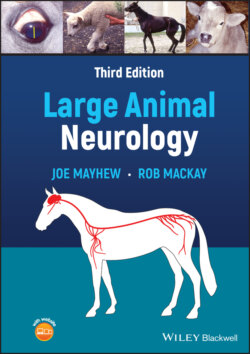Читать книгу Large Animal Neurology - Joe Mayhew - Страница 76
Gross lesions
ОглавлениеMalformations of the CNS usually are apparent on careful gross inspection. However, associated structures such as eyeballs, peripheral nerves, bones, and muscles as well as midline structures such as heart and great vessels should be scrutinized for accompanying defects. The outside of the brain and spinal cord should be studied for abnormalities in color, configuration, regional size and texture, and the brain can then be cut into four to six transverse sections to assist in fixation. Examining these freshly cut surfaces, especially for symmetry, can help locate areas of malacia, hemorrhage, atrophy, and swelling. Small (and even large) lesions may not be clinically significant in several regions of the forebrain (Figure 4.3). If cerebellar atrophy or hypoplasia is suspected, the cerebellum to total brain weight ratio should be calculated (normal >7%). Parasite tracts and inflammatory lesions can be inconspicuous. A culture taken from the meninges and saving a small portion of brain tissue for viral and bacterial isolation, especially from areas of discoloration, is advisable. In animals suspected of having rabies, appropriate samples need to be prepared for submission to the local animal health authorities. This may entail preparing the whole head or all/part of the brain for shipment and requires that appropriate precautions be followed during harvesting and shipping.
Figure 4.3 Small volumes of necrosis of CNS tissue result in astrocytic scars. Such lesions of many millimeters and greater usually result in cystic cavities lined by astrocytic fibers and residual inflammatory cells. The latter may include cells such as hemosiderin‐laden macrophages as was the case here in a yearling foal that recovered completely from a perinatal hypoxic–ischemic event as a neonatal foal leaving porencephalic, fluid‐filled cysts such as the one shown here in one internal capsule on this transverse section of the fixed brain.
If care is used in removing the spinal cord, areas of compression and discoloration associated with necrosis, hemorrhage, or inflammation can be detected easily. Obviously, one cannot section every part of the CNS, so an effort must be made to maintain orientation of the parts. If one suspects the presence of a gross lesion, then an examination of newly made cut surfaces of the fixed tissue should provide clarification.
